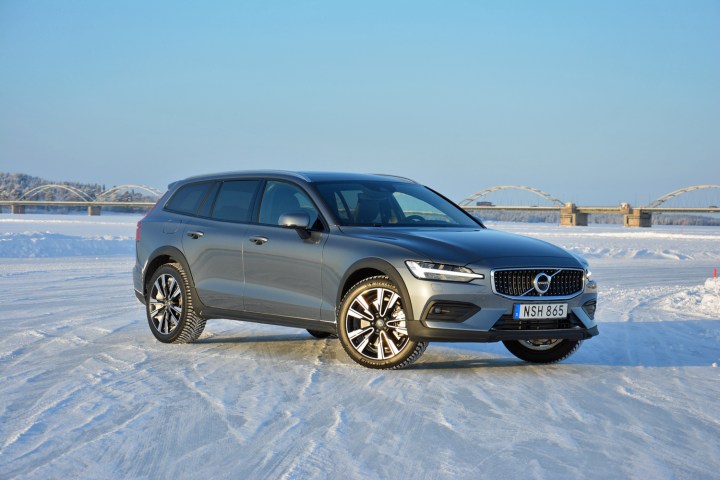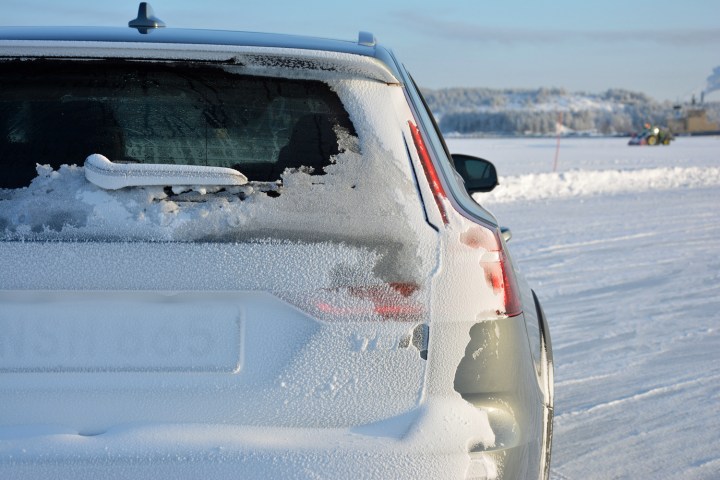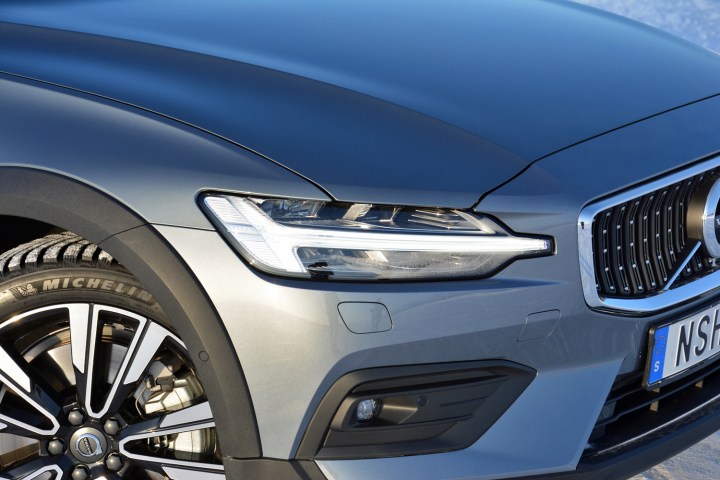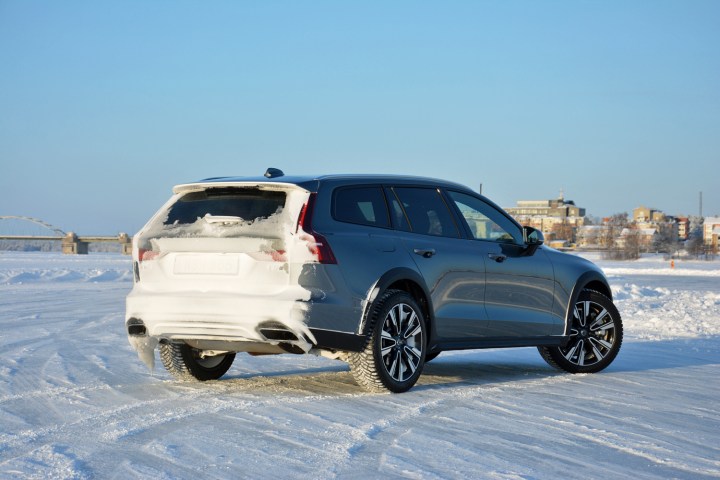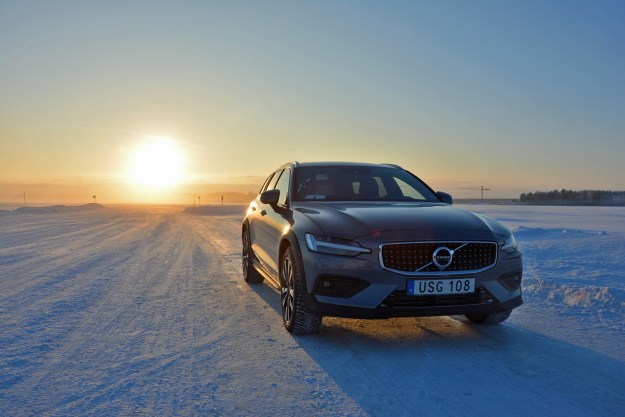
“Comfort, tech, practicality, and all-weather prowess converge in the Volvo V60 Cross Country.”
- Elegant design
- Winter-beating AWD
- Intuitive infotainment system
- Spacious, well-appointed interior
- Clunky automatic transmission
- Less engaging than rivals
“This is where you’ll start your drive,” said the shuttle driver who picked me up from the airport. He pointed to a frozen bay across from the town of Luleå in northern Sweden, a stone’s throw from the Arctic Circle. “This can’t be it,” I thought as I looked at people casually pushing their kids on ice sleds. I’m here to drive a new car, not to go ice-skating or live a day in the life of a snow plow driver.
Less than five minutes later I stood on about a yard of rock-solid ice in front of a row of neatly-parked Volvo V60 Cross Country station wagons. It was -16 Fahrenheit before wind chill brutally entered the equation, which was cold enough to make holding a bottle of water without gloves on an onerous task, but the V60 Cross Country was designed to effortlessly tackle these conditions.
As its name implies, the Cross Country is based on the V60 station wagon, but it traded its Stan Smiths for a pair of REI hiking boots. The badge also brings standard all-wheel drive and more ground clearance, among other winter-taming goodies.
Volvo hasn’t released pricing information for the 2020 V60 Cross Country yet. We expect it will cost about $1,000 more than the standard V60, which carries a base price of $38,900. When it arrives in American showrooms, it will be offered in a single trim level, and with a single engine. The Cross Country’s full list of standard and optional equipment won’t be published until closer to its on-sale date, which will be during the first quarter of 2019, and deliveries will begin the following July.
The Swedish army knife
Volvo showed a surprising amount of foresight when it unveiled the V70 Cross Country at the 1997 Frankfurt auto show. It was based on the standard V70, but it gained additional ground clearance, all-wheel drive, plus an array of Cross Country-specific trim pieces. The Swedish firm swung a hammer in the dark and hit the nail right on the head; buyers in cold climates couldn’t get enough of the V70 XC.
The V60 Cross Country, like all of its predecessors and its modern-day siblings, follows the same recipe. Starting with a regular, second-generation V60, which Volvo released in 2018, designers added model-specific bumpers on both ends, and protective plastic cladding over the rocker panels and the wheel arches. Engineers then raised the ground clearance by 2.9 inches. While the Cross Country isn’t a bona fide off-roader, it allows motorists who regularly travel on dirt roads to spend less time worrying about rocks punching the underbody and more time driving. I think the outdoorsy look suits the V60 well, too.
The sheet metal hides Volvo’s modular SPA architecture, which is also found under the S90 and its derivatives, the XC90, the S60, and the XC60. Most motorists won’t notice the common platform, but they’ll detect the V60 Cross Country shares many interior parts with its bigger siblings. SPA-based models use the same infotainment system, steering wheel, and digital instrument cluster, among other components.
If you’ve driven a late-model Volvo, you’ll experience déjà vu after sitting in the V60 Cross Country.
They also share a comfort-minded approach to interior design that places the passengers front and center. The materials look and feel upmarket with an undeniably Scandinavian spin; significantly, they feel as nice as the ones Audi puts in the A4 Allroad, the V60’s most direct rival.
The Cross Country offers 29.7 cubic feet of trunk space with four passengers on-board. Folding the rear seats into the floor yields 48.2 cubes; that’s big enough for serious Ikea-ing. In comparison, the aforementioned A4 Allroad initially trails the V60 with 24.2 cubic feet, but it leaps ahead with 58.5 cubes once motorists cast the seatus-disappearus spell to hide the rear bench. V60 Cross Country buyers are highly likely to also look at the XC60, so keep in mind Volvo’s mid-range SUV offers 30.8 and 67.4 cubes with one and two rows of seats left up, respectively.
Familiar tech
If you’ve driven or sat in a late-model Volvo, you’ll experience déjà vu after taking a peek inside the V60 Cross Country. It receives the exact same Sensus infotainment system found in the bigger, costlier V90 that’s positioned in the next segment up. It’s displayed on a portrait-oriented screen embedded in the center stack and framed by a black bezel. The system replaces dozens of buttons, though Volvo wisely retained a small cluster of them – including a real volume knob – in the space right below the screen.
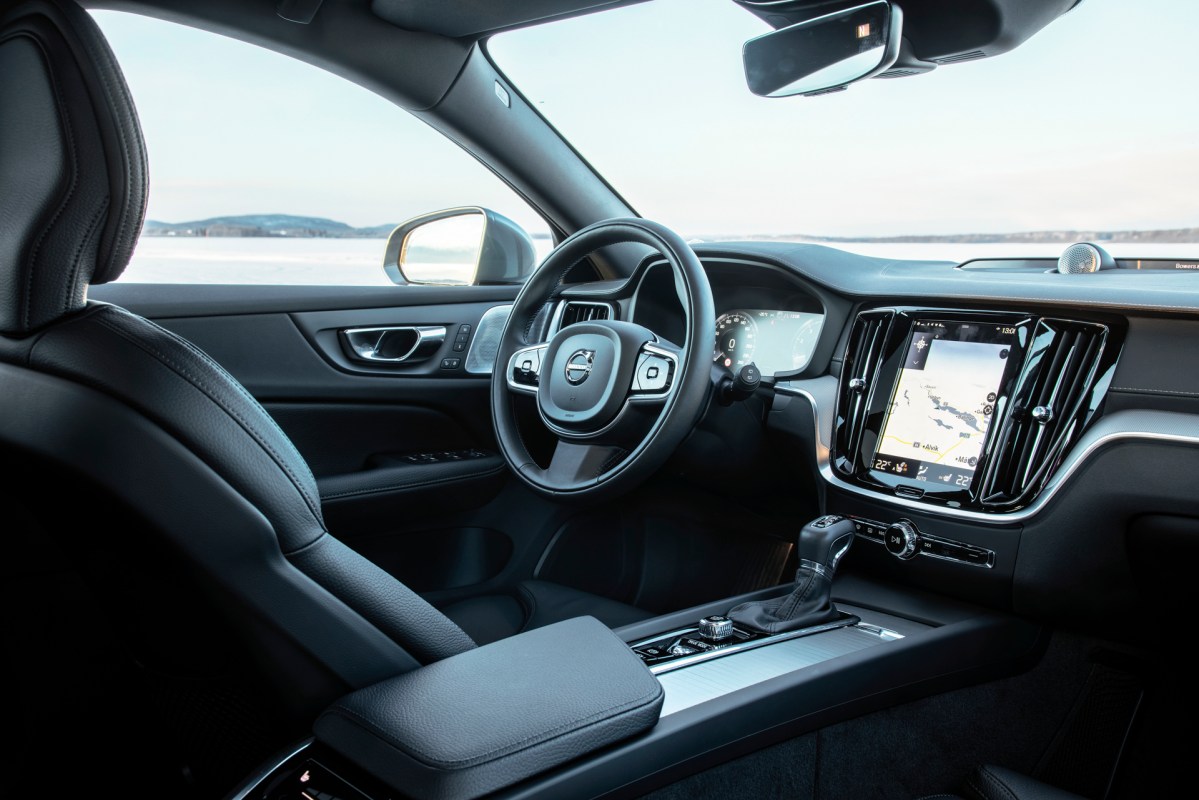
Sensus is no longer the newest infotainment system on the block, but it remains one of my favorites because it displays information in a relatively clear, logical, and intuitive way. The home menu provides five basic options: Navigation, media, connectivity, sound settings, and climate settings. Alternatively, passengers can use swiping motions to access built-in applications (like weather information and local search) or the numerous car functions (such as lane-keeping assist, park assist, and the start-stop system).
Nearly everything is where you expect to find it, and it’s easy to create mental shortcuts to commonly-used features because the menus are fairly shallow. Recent hardware updates make Sensus faster than before, too, and the graphics are generally good. But, if Sensus just doesn’t grow on you, keep in mind it’s compatible with Android Auto and Apple CarPlay.
I had no trouble reading information on my test car’s digital instrument cluster. It’s another piece of tech that has trickled down from bigger models. The V90 Cross Country I drove in 2017 used the same cluster. The screen gets the job done, and it reduces distractions by putting a map with turn-by-turn navigation directions right in the driver’s line of sight, but it isn’t as interactive or feature-rich as the Virtual Cockpit offered optionally on the A4 Allroad.
Taming the ice
Volvo is making life easy for motorists shopping for a V60 Cross Country. It’s a mono-spec model, and it’s only available with a single engine. Called T5, the unit in question is a turbocharged, 2.0-liter four-cylinder tuned to deliver 250 horsepower at 5,500 rpm and 258 pound-feet of torque over a broad band that stretches from 1,800 to 4,800 rpm. In simpler terms, the torque is always there when you need it.

All-wheel drive is optional on the regular V60; it’s standard on the Cross Country. The turbo four’s power travels to the pavement – or, in this case, the ice – via an eight-speed automatic transmission.
The V60 Cross Country and I traveled to a remote part of Sweden where it snows so much during the winter that the roads are rarely clear. This picturesque environment made it nearly impossible to fully evaluate the wagon’s on-road comfort. The regular V60 impressed me with its refined, relaxing ride (I called it cool, calm, and collected), and I don’t see why the Cross Country would be any different. Besides, my time with Cross Country-ified Volvo models has taught me they’re usually more supple than the cars they’re based on.
After Volvo let me loose on the ice, I discovered a side of the V60 few buyers will ever meet. The ones that do will be reassured to find it, however.
Its handling is pleasantly predictable but not terribly engaging, and the brakes scrub off speed with a “don’t worry, we got this” attitude.
Helped by studded snow tires, the Cross Country clenched to the road and almost never let go. The laws of physics will always win the battle against all-wheel drive and electronic wizardry, but the V60 surprised me with confident and sure-footed handling where I expected it to skid out of control like a puck on an air hockey table. It even tackled a slalom course set up on the frozen bay at about 45 mph without putting a wrong foot. Short of entering a turn with way too much speed, the only way to get the tires to loosen their grip is to turn the traction control off.
I eventually left the ice, but I didn’t leave ice behind. Most of the roads I traveled on were covered with snow, ice, or both, and knowing that the Cross Country’s all-wheel drive system stayed alert to keep me pointed in the right direction – and away from the towering trees on either side of the pavement – brought a tremendous amount of peace of mind. Instead of white-knuckling the steering wheel through frozen turns, I turned every accessory that starts with “heated” on full blast, and enjoyed the nearly-Arctic scenery that wrapped around the car.
Merging onto the highway for a brief stint of high-speed driving revealed the 250-horsepower turbo four has enough muscle to move the V60 Cross Country briskly. It’s not a fast wagon by any means, but it has enough pep in its step to satisfy the needs of the average motorist; Volvo quotes a zero-to-60-mph time of 6.8 seconds, which is about a second slower than the A4 Allroad.
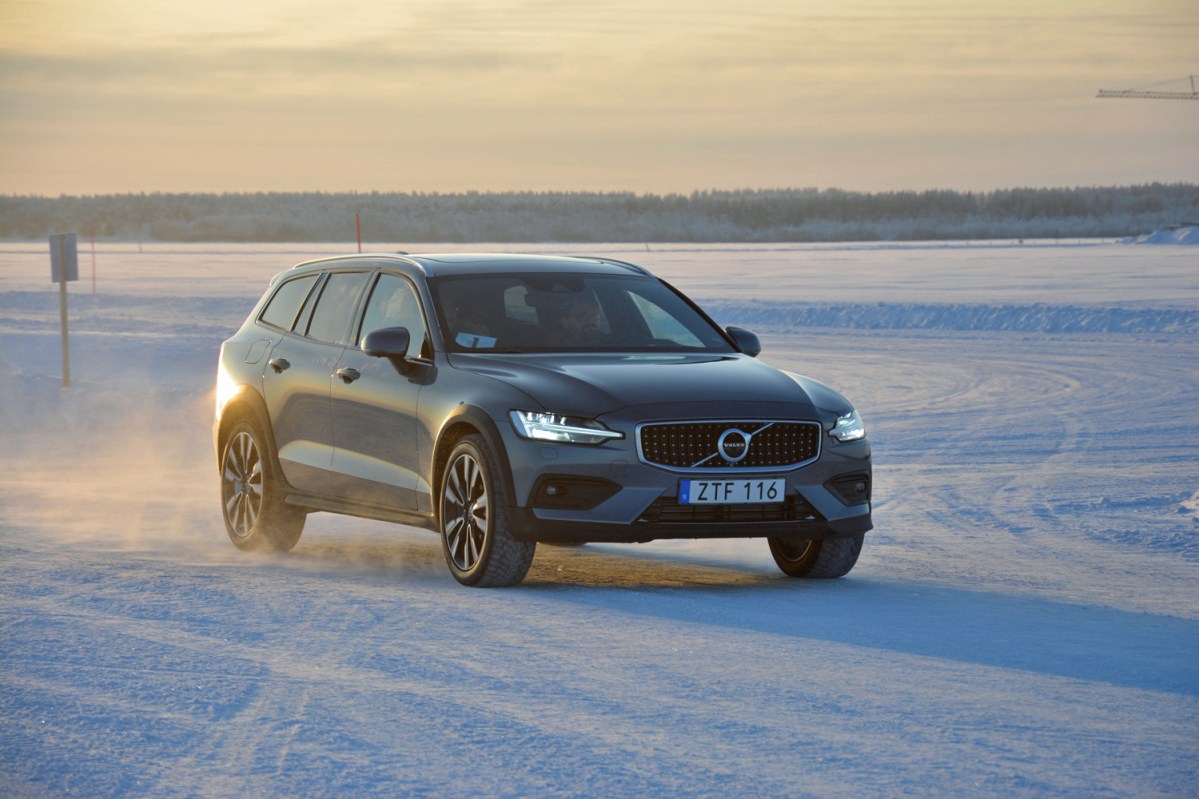
It reaches freeway speeds in a smooth, linear manner, but it shares its progress with the passengers at nearly every step of the way. The T5 engine’s groan fills the cabin under heavy acceleration, though it quiets down considerably once the V60 reaches its cruising speed. From that point on, it’s restful, composed cruising bolstered by a comfortable suspension that filters out most irregularities in the pavement. Its handling is predictable but not terribly engaging, which is what I expect from a Volvo wagon, and the brakes scrub off speed with a “don’t worry, we got this” attitude.
The drivetrain’s biggest let-down is the transmission, which is occasionally confused and jerky at low speeds (like when driving through a city), or when it needs to downshift. The V60 Cross Country needs shift paddles like a Jeep Wrangler needs a track mode and a carbon fiber diffuser, but Volvo nonetheless gives drivers the option of selecting their own gear by using the lever in the center console. It’s a feature I rarely used.
I didn’t spend enough time behind the wheel to measure the V60 Cross Country’s fuel economy. The Environmental Protection Agency (EPA) won’t release its figures until closer to the wagon’s on-sale date.
Wagons ho!
Automakers are leaving the station wagon segment so quickly that we have to check its pulse on a regular basis. The V60 Cross Country competes in a niche within a niche, but it’s not alone in its competitive set. Its closest rival is the Audi A4 Allroad, a model which starts at $45,700.
Allroad is Audi-speak for Cross Country. Based on the A4 Avant, which is not sold in the United States, the Allroad model receives rugged-looking plastic trim, standard Quattro all-wheel drive, and more space between the rocker panels and the ground. If that sounds familiar, it’s because the Allroad and the Cross Country are variations of the same theme. The Audi handles better than the Volvo, and it’s considerably quicker, but it’s not as comfortable. It’s also about $5,000 more expensive.
Peace of mind
We’ll need to wait until Volvo releases additional information about the V60 Cross Country to find out about the safety features it comes standard with, and the equipment buyers need to pay extra for. To add context, every V60 is equipped with dual front, front side, and curtain airbags in addition to a knee airbag for the driver. Volvo also includes lane-keeping assist, oncoming lane mitigation, a whiplash protection system, and road sign information technology. Semi-autonomous Pilot Assist technology (which combines adaptive cruise control and lane-keeping assist) is optionally available on the V60.
Like every new Volvo, the V60 Cross Country will boast a four-year, 50,000-mile warranty.
Conclusion
It’s not difficult to see why Volvo remains committed to the station wagon segment even as its rivals run away from it like they’re fleeing a nuclear explosion. The V60 Cross Country represents a nearly compromise-free alternative to a compact luxury SUV like the XC60 for buyers seeking space for passengers and gear plus winter-beating all-wheel drive. And, as SUVs and crossovers invade every driveway in America, owning a station wagon might soon become cool again.

